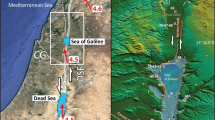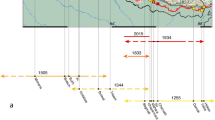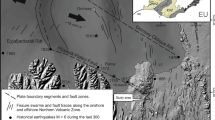Abstract
Over 2,000 km of seismic reflection profiles have been collected in Lake Malaŵi (Nyasa), the southernmost of the East African Rift Lakes. These studies, reported here, reveal a severely faulted lake floor bounded by rift structures of Pliocene or greater age. Faults that penetrate the uppermost sedimentary units and numerous earthquakes1 attest to continuing activity in the rift. Inter-basinal differences in fault spacing, orientation and sedimentary thicknesses have led to a subdivision of Lake Malaŵi into four discrete structural provinces. These provinces only now are linked by faults attributed to the most recent episodes of extension. An evolutionary sequence of: (1) initial block faulting and subsidence, (2) fragmentation of fault blocks, (3) uplift and (4) renewed subsidence and rotation of fault blocks is proposed for the central part of the Malaŵi Rift.
This is a preview of subscription content, access via your institution
Access options
Subscribe to this journal
Receive 51 print issues and online access
$199.00 per year
only $3.90 per issue
Buy this article
- Purchase on Springer Link
- Instant access to full article PDF
Prices may be subject to local taxes which are calculated during checkout
Similar content being viewed by others
References
Fairhead, J. 20th a. Rep. res. Inst. Afr. Geol. Univ. Leeds, 42–46 (Leeds Univ., 1976).
Rosendahl, B. & Livingstone, D. Episodes 1983, 14–19 (1983).
Eccles, D. Limnol. Oceanogr. 19, 730–742 (1974).
Crossley, R. & Crow, M. Geodyn. Evol. Afro-Arab. Rift Syst., 77–87 (Accad. Nazion. dei Lincei, 1980).
Girdler, R. & Sowerbutts, W. J. Geomag. Geoelect. 22, 153–162 (1970).
Dixey, F. Q. Jl geol. Soc. Lond. 83, 75–108 (1929).
Bloomfield, K. & Garson, M. Bull. geol. Surv. Malaŵi 17 (1965).
Kaufulu, Z., Vrba, E. & White, T. Ann. Transv. Mus. 33, 1–8 (1980).
Crossley, R. Paleoecol. Afr. 15, 139–144 (1982).
Carter, G. & Bennett, J. Bull. geol. Surv. Malaŵi 6 (1973).
Von Herzen, R. & Vacquier, V. Geophys. Res. 72, 4221–4226 (1967).
Yairi, K. 2nd Prelim. Rep. Afr. Stud. Nagoyu Univ., 51–69 (Nagoya Univ., 1977).
Muller, G. & Forstner, U. Miner. Deposita 8, 278–290 (1973).
Bloomfield, K. Nature 211, 612–614 (1966).
Cape, C., McGeary, S. & Thompson, B. Geol. Soc. Am. 94, 3–14 (1983).
Harkin, D. Mem. Geol. Tanganyika 2 (1960).
Ziegler, P. Nature 304, 561 (1983).
Lister, L. Rec. geol. Sun. Malaŵi 7, 15–28 (1967).
Baker, B., Crossley, R. & Goles, G. Petrology and Geochemistry of Continental Rifts (eds Neumann; E. & Ramburg, I.) 62–78 (Reidel, Dordrecht, 1978).
Author information
Authors and Affiliations
Rights and permissions
About this article
Cite this article
Ebinger, C., Crow, M., Rosendahl, B. et al. Structural evolution of Lake Malaŵi, Africa. Nature 308, 627–629 (1984). https://doi.org/10.1038/308627a0
Received:
Accepted:
Issue Date:
DOI: https://doi.org/10.1038/308627a0
This article is cited by
-
Lake level oscillations recorded in Buracica Stage (Barremian, Early Cretaceous) of Recôncavo Basin, Bahia State (N.E. Brazil)
Journal of Sedimentary Environments (2020)
Comments
By submitting a comment you agree to abide by our Terms and Community Guidelines. If you find something abusive or that does not comply with our terms or guidelines please flag it as inappropriate.



